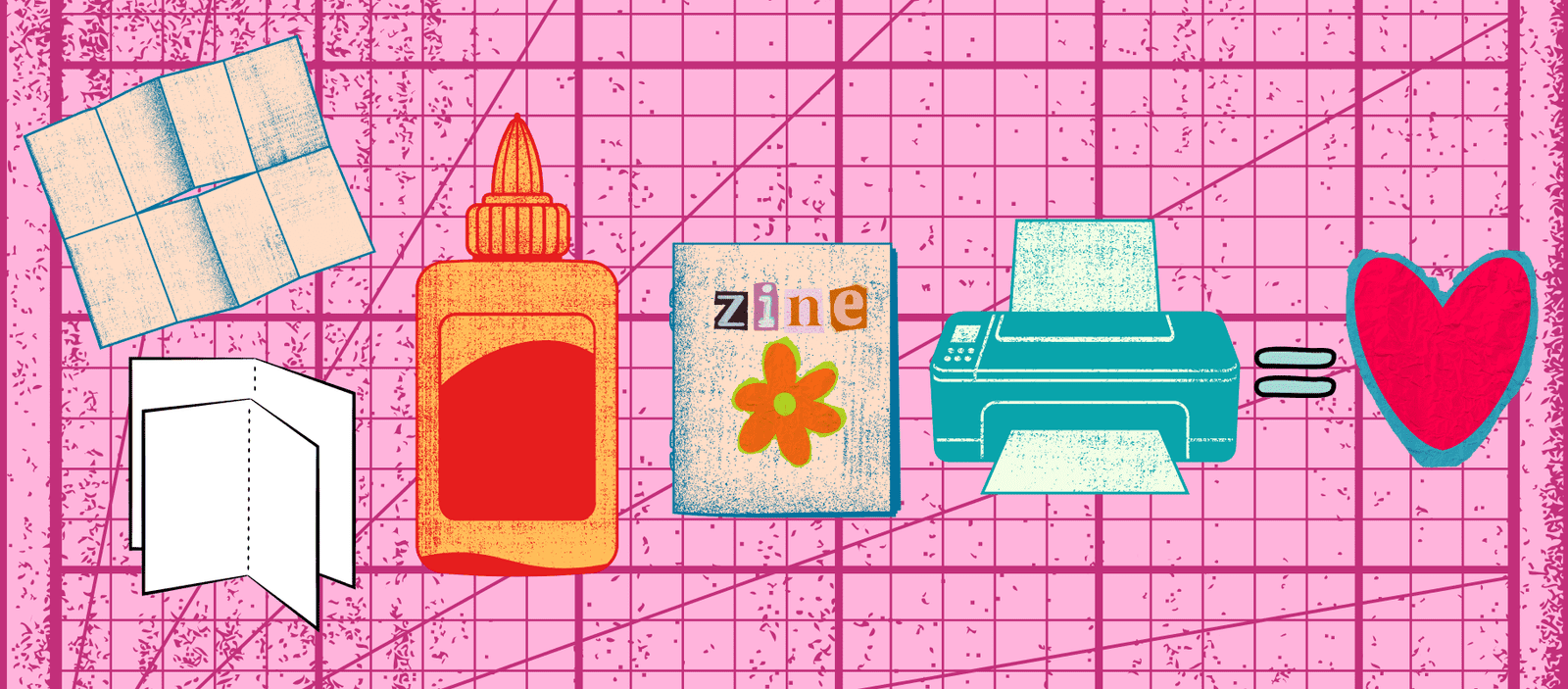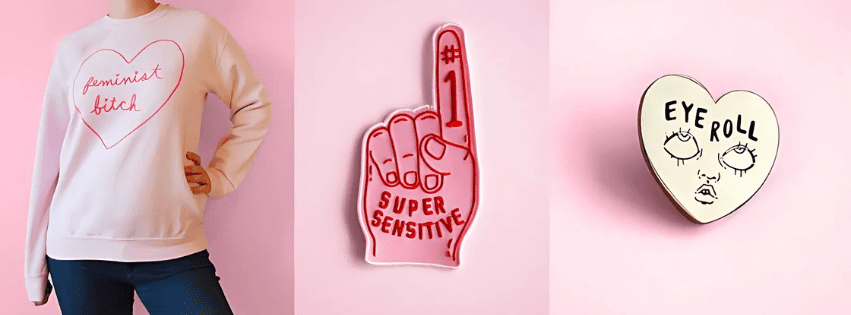There’s a kind of magic in a glue stick. In the aroma of fresh photocopies. In the way a piece of scrap paper can carry your voice louder than a glossy magazine ever could. That’s the power of the zine—equal parts manifesto, mixtape, diary, rebellion, and community bulletin board.
Zines aren’t just “DIY magazines” (though they are that, too). They’re tiny, folded acts of resistance. They’re how we scream into the void and hear each other scream back. In a world begging us to be polished and marketable, zines say: “Fuck it. Be messy. Be loud. Be yours.”
This is your starter kit. Your punk syllabus. Your cut-and-paste permission slip. Welcome to Zines 101.

What Is a Zine, Really?
A zine (short for fanzine or magazine) is a self-published, small-batch print publication that’s made without corporate interference or mainstream approval. Zines are often photocopied, stapled, and traded or sold for a few bucks (if at all). They’re anti-algorithm. Anti-perfection. Anti-institutional.
They’ve been around in some form since the 1930s sci-fi fandoms, exploded in the 70s punk scene, and became a lifeline during the riot grrrl movement of the 90s. Zines are where queers, punks, anarchists, loners, lovers, artists, weirdos, and outcasts have always gone to speak freely.
One of the first books that I got waaay back in the day about zine making was “Make A Zine” by Bill Brent and Joe Biel. If you can get your hands on it, it’s worth the fare to your local library or indie bookstore. #notanad
Zines are not about followers. They’re about finding your people.

Why Zines Matter (More Than Ever)
We live in a time of monetized opinions, curated identities, and sponsored rebellion. Social media has given everyone a platform but taken away our privacy, nuance, and attention spans.
Zines reject the need to perform. They don’t care if you have the right font or the right politics. They just care if you mean it.
They offer something almost extinct in 2025: slowness. Intimacy. Impermanence. Tangibility. Zines don’t live in an algorithm—they live in backpacks and bathroom floors and shoeboxes under your bed.
They matter because they don’t scale. And that’s the point.

What You’ll Need to Make One
Let’s keep this delightfully analog:
-
Paper: Any kind will do—printer paper, cardstock, old receipts, junk mail.
-
Scissors: Fancy or blunt doesn’t matter. Just get slicing.
-
Glue sticks or tape: For the real ones, UHU is non-negotiable.
-
Pens, markers, typewriters, paint: Whatever gets your thoughts out of your brain and onto the page.
-
Old magazines, newspapers, photos: Welcome to collage city.
-
A stapler: Saddle staplers work best, but two staples and a strong thumb is classic.
And if you’re going digital before going analog:
-
Scanner or printer/copier
-
Layout software (optional): Canva, InDesign, Affinity Publisher, or just PowerPoint in a panic.

How to Make One (Step by Step)
Step 1: Pick a size
The most common format is a folded 8.5×11 sheet (which gives you 8 pages). But do what you want. Quarter-size, full-page, tiny zines, poster zines—there are no rules.
Step 2: Decide on your theme or vibe
You don’t need a strict topic, but a loose theme helps. Your breakup? Climate grief? Black cats of the neighbourhood? Do it.
Step 3: Create your pages
Start cutting, pasting, typing, scribbling. Don’t wait to make it perfect. Zines are built on impulse and imperfection.
Step 4: Assemble & duplicate
Once your pages are laid out, make photocopies or scans. Staple them. Fold them. Hold the first finished copy like it’s a newborn rat baby. It’s yours.
Step 5: Share it
Trade with friends. Sell it at zine fairs. Slide it into books at the library. Mail it to strangers. Post a few pics online if you must, but keep the soul offline.

What Goes Inside?
Anything. Seriously:
-
Personal essays
-
Political rants
-
Comics or doodles
-
Horoscopes for your exes
-
Collages of grocery lists
-
Interviews with your friends’ cats
-
Recipes, playlists, fake classifieds
-
Poems, jokes, found text, rants, dreams
A zine is a junk drawer for your brain. And sometimes, junk drawers are more beautiful than display cabinets.

Zine Ethics: Some Notes
-
Credit your sources when possible—especially for found images or work that’s not yours.
-
Respect your community. Zines often share intimate things. Honour that vulnerability.
-
Avoid appropriation. Zine culture is rooted in resistance—don’t replicate the same harm it exists to fight.
-
Consent matters. Don’t publish someone’s face, quote, or story without asking. Yes, even in collage form.

Where to Find Zines (And Zine People)
-
Local zine fairs or indie bookshops
-
Libraries with zine collections (Toronto, Winnipeg, Montreal—all got ’em)
-
Websites like Etsy, Big Cartel, and so many others
-
Instagram, yes—but go offline to truly connect
-
Trade! Nothing is more punk than a postal exchange
- Check our ‘Events and Meetups‘ page and write us at hello@shezinemag.com to submit your zine events!

Your First Zine Checklist
(Optional, but highly recommended for maximum chaos)
✅ A loose idea or theme (but “my brain at 3 a.m.” is also valid)
✅ Paper—scrap, printer, found, stolen from the office
✅ Scissors or an X-Acto knife
✅ Glue stick or tape (UHU preferred, but we’re not glue snobs)
✅ Markers, pens, paint, typewriter, or ransom-note letters
✅ Old magazines, flyers, junk mail, receipts
✅ A stapler (bonus points for a long-arm stapler)
✅ Photocopier, scanner, or printer (library ones work fine)
✅ A place to spread out (floor, bed, café table, abandoned parking lot)
✅ A soundtrack (riot grrrl, sad indie, power pop—whatever fuels your scissors)
✅ At least one thing that makes you nervous to include (good sign)
✅ A friend to trade with—or a stranger to surprise
✅ A deep breath (because no one’s judging, least of all your zine)
Remember: no one has to “get it” but you and your future self.

Zine Lingo 101
(Speak fluent zinester in under 3 minutes.)
Zine – A handmade, self-published booklet, often photocopied and full of feelings.
Zinester – A person who makes zines. Often also makes tea at midnight and feels things too deeply.
Perzine – Short for “personal zine.” It’s your diary but louder and shared with strangers.
Fanzine – A zine about something you’re obsessed with (bands, movies, moths, etc.).
Mini-zine – A tiny zine, often made from a single folded sheet of paper. Cute as hell.
Saddle stitch – A double-thread hand-stitching technique using two needles and one thread to form a strong, interlocking seam. In zine-speak, it’s also the fancy way of saying “stapled down the middle.”
Distros – Short for “distributors.” They sell and trade zines, often online or at fairs.
Zine fair – A pop-up market for zinesters. Expect stickers, awkward eye contact, and paper cuts.
Copyleft – The opposite of copyright; an anti-capitalist invitation to remix, reuse, and resist.
Mail art – The practice of sending decorated letters or zines by post. Also: joy in envelope form.
One-off – A single-copy zine, often super personal or experimental.
The She Zine Manifesto (Because You Deserve One)
We believe in messy art, in unpolished feelings, in paper cuts and typo-ridden poetry.
We believe your voice matters before it’s optimized, monetized, or sanitized.
We believe in slow content, ugly fonts, inside jokes, and outsider politics.
We believe zines are time capsules, love letters, protest signs, and daydreams.
We believe in scissors and glue sticks and giving a damn.
We believe in you.
Here’s a little snippet of inspiration from Miranda July at the Brooklyn Museum, because of course it is…
The Printer’s Cooled and the Paper’s Hot—So Now What???
Holy moly, do we ever want to see your zine.
We’ll be launching our store very soon, with our official zine shop, The Stack. And guess what? We want your zines on our digital rack.
We’re currently accepting submissions from indie, DIY’d, handmade-with-love (or humour or rage) publications. If you’ve made something real—something weird, beautiful, chaotic, honest—we want it.
To submit, email us at thestack@shezinemag.com.
If this is your first attempt at zine-making, keep an eye out for our Zine Starter Pack — a little guide with all the tips outlined above, some prompts to get your creative juices flowing, and a basic set of tools. Basically everything you need to know to properly submit, price, and promote your zine. You’ll also find out how to connect with other zinesters and get your work into more hands.
A few zines will even be selected to be featured across our social channels, so if you want the internet to fall in love with your brain, now’s the time.
And just so we’re clear:
No hate. No gross stuff. No bigotry.
We’re a pretty open publication, so if something crosses the line, it’ll be obvious. Keep it kind, keep it cool.
If you’re excited, that’s amazing—because we are too.
Now go make a zine!!
→ Subscribe to The Edit
→ Submit Your Work
→ Follow @shezinemagazine
If you would like to receive She Zine’s monthly digital zine, sign up for our newsletter via the ‘Subscribe‘ link above!

AXO (she/her) is a multidisciplinary creator, editor, and builder of feminist media ecosystems based in Toronto. She is the founder of She Zine Mag, Side Project Distro, BBLGM Club, and several other projects under the AXO&Co umbrella — each rooted in DIY culture, creative rebellion, and community care. Her work explores the intersection of craft, technology, and consciousness, with an emphasis on handmade ethics, neurodivergent creativity, and the politics of making. She is an advocate for accessible creativity and the power of small-scale cultural production to spark social change. Her practice merges punk, print, and digital media while refusing to separate the emotional from the practical. Above all, her work invites others to build creative lives that are thoughtful, defiant, and deeply handmade.
























